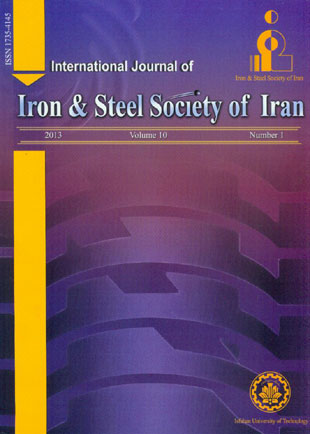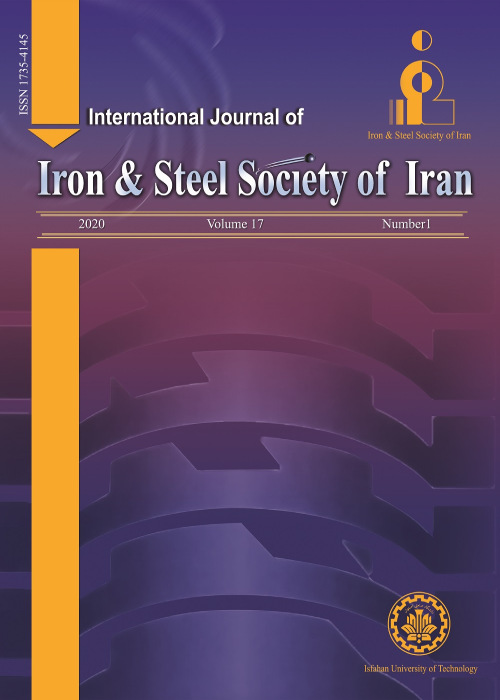فهرست مطالب

International Journal of iron and steel society of Iran
Volume:10 Issue: 1, Summer and Autumn 2013
- تاریخ انتشار: 1393/01/25
- تعداد عناوین: 7
-
-
Pages 1-6A series of TiAlON coatings were synthesized in a gaseous mixture of argon, nitrogen and oxygen by cathodic arc evaporation method using a Ti–Al mosaic target. Oxidation of coatings was carried out by heating the coated samples at the temperatures of 500, 600, 700, and 800°C for 1 h in air atmosphere. It was found that heat treatment changed the microstructure and composition of the coating. The dark copper color of TiAlON films was also changed due to the heat treatment. The peak intensities of TiN were decreased and that of Fe was increased with an increase in heat treatment temperature. Furthermore, the amorphous Al2O3 in grain boundaries was transformed to a crystalline structure with increasing temperature. The variation in the chemical composition of the coatings was recognized to be a function of heat treatment temperature. The oxidizing treatment promoted not only the growth of titanium and aluminum oxides on the pore wall of the coating, thereby allowing a partial pore sealing, but also the inter diffusion processes which increased the coating internal cohesion. The structure of TiAlON coatings was studied using X-ray diffraction (XRD) and scanning electron microscopy (SEM). Morphological characteristics were analyzed by means of an Atomic Force Microscopy (AFM). Corrosion resistance tests carried out in the 3.5%wt NaCl solution showed reduced corrosion current density due to the oxidation treatment. This post-coating treatment could be effective in improving the corrosion protection of TiAlON coating on a D3 substrate.Keywords: Cathodic arc evaporation, TiAlON coating, Corrosion resistance, Heat treatment
-
Pages 7-13In this paper, the electrochemical behaviour of passive films formed on AISI 321 stainless steel (AISI 321) immersed in 0.1 M NaOH + 0.1 M KOH solution was evaluated by different electrochemical techniques. For this purpose, passive films were formed at open circuit potential for 1 to 12 hours and then electrochemical measurements were done. The polarization curves suggested that AISI 321 showed excellent passive behaviour in 0.1 M NaOH + 0.1 M KOH solution. Mott–Schottky analysis indicated that the accepted densities were in the range of 1021 cm-3 and decreased with immersion time. Electrochemical impedance spectroscopy (EIS) results showed that the best electrical equivalent circuit presented two time constants: The high-medium frequencies time constant could be correlated with the charge transfer process and the low frequencies time constant was associated with redox processes taking place in the surface film. Also, EIS results showed that polarization resistance was increased with formation time from 1 until 12 hours, due to the thickening of passive film.Keywords: stainless steel, Passive film, Mott–Schottky, EIS
-
Pages 14-22One of the problems in the case of stainless steels is their low corrosion resistance against pitting corrosion in chloride containing environments, thereby leading to severe damage to industries. In this research, the pitting corrosion of 304 austenitic stainless steel was studied in 3.5% NaCl solution at room temperature (25˚C) by performing electrochemical measurements (containing cyclic polarization and electrochemical impedance spectroscopy) and immersion measurements. Moreover, the effect of adding different concentrations of PEI inhibitor with two mean molar masses (2000 and 60,000 g/mol) on pitting corrosion was investigated. Finally, the adsorption behavior of this inhibitor on the alloy surface was investigated by ATR-FT.IR and AFM methods. It was observed that both inhibitors prevented uniform and pitting corrosion successfully, but PEI (60,000 g/mol) had better inhibition efficiency than PEI (2000 g/mol).Keywords: Pitting corrosion, Polyethyleneimine (PEI), Inhibitor, NaCl solution, Austenitic stainless steel
-
Pages 23-26One of the most important methods to produce sponge iron is coal based reduction of iron ore. Direct reduction methods based on coal are being improved due to the abundance of coal sources and its lower cost in comparison with natural gas. Volatile materials in coal play an important role in the reduction of iron oxides. In this study, noncoking coal with high volatile materials from Iran and commercial hematite with the purity of 98% were used to investigate the effect of volatile materials on the reduction process. The effects of reduction time (0 to 75 minutes), temperature of reduction (700 to 1000 oC), particle size of coal (53 to 250 micron), and the ratio of carbon content of coal to hematite (0.9 to 1.2) were investigated. The results indicated that volatile materials could reduce 56% of iron oxide. The XRD results of reduced materials implied the stepwise reduction process. Furthermore, activation energy was increased with increasing the degree of reduction.Keywords: Reduction of Hematite, Volatile Materials, Coal
-
Pages 27-33Gas tungsten arc welding is a popular process in those applications requiring a high degree of quality and accuracy. However, this process has a big disadvantage against the substantially high productivity welding procedures. Hence, many efforts have been made to improve its productivity. One of these efforts is the use of activating flux (A-TIG welding). In this study, the performance of A-TIG welding on 304L austenitic stainless steel plates has been presented. Two oxide fluxes, TiO2 and SiO2 were used to investigate the effect of A-TIG welding process on weld morphology, microstructure and mechanical properties of weldments. The experimental results indicated that A-TIG welding could increase the weld penetration and depth-to-wide ratio. It was also found that A-TIG welding could increase the delta-ferrite content of weld metals and improve the mechanical properties. Moreover, a 2D axial symmetric model was developed to simulate the flow behavior in the melting pool. These results were compared to those experiments carried out on a stainless steel (304L) melted by a stationary heat source.Keywords: A, TIG welding, delta, ferrite, stainless steel, oxide flux
-
Pages 34-36Binders are of prime importance in the agglomeration of iron ore concentrates. In this research, strength and density of briquette produced from the magnetite concentrate of Gol-E-Gohar were investigated using different binders at various applied pressures. The results showed that peridor was the most effective binder relative to bentonite and lime. For all types of binders, the increase in binder content increased the strength and decreased the density of briquette. The increase in the applied pressure during the preparation of briquette also increased strength and density, but this occurred at different rates when different types of binders were used.Keywords: Bentonite, Iron, ore concentrate, briquette, Peridor
-
Pages 37-42In the present research, damage mechanisms during room temperature uniaxial tensile testing of two different modern high strength dual phase steels,DP780 and DP980, were studied. Detailed microstructural characterization of the strained and sectioned samples was performed by scanning electron microscopy (SEM). The results revealed that interface decohesion, especially at the triple junctions of ferrite-ferrite-martensite, was the most probable mechanism for void nucleation. Also, it was found that ductile fracture in these steels was nucleation controlled such that just before ductile fracture incidence, a high density of voids would nucleate or a sudden accelerated void nucleation could happen. Microscopic observations as well as statistical analysis confirmed this phenomenon. Moreover, damage analysis suggested that the void nucleation rate was higher in DP980 than DP780 steel. It seemed to be highly influenced by the morphology and distribution of martensite particles within the ferrite matrix.Keywords: Dual phase steel, Damage mechanism, Interface strength


